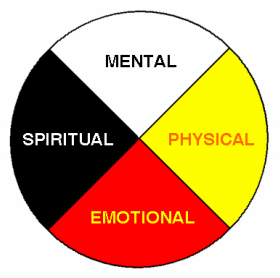Culturally relevant evaluation framework
 In a resource for the American Evaluation Association, Susan Jenkins reflected about working on evaluation with Native American/American Indian and Alaska Native tribal governments. She points to a resource on evaluation that she found useful in her work with tribal governments, and that I think has a lot of important uses in various cultures. The Medicine Wheel Evaluation Framework, described by the Atlantic Council for International Cooperation, aims to be a more holistic approach to evaluation than our typical models. Most evaluations seek to find out which activities led to which changes, in a very linear way. Just think about a logic model — we may know intuitively that there are feedback loops and bigger pictures that affect our program and our evaluation, but there aren’t great ways to depict that in our logic model framework.
In a resource for the American Evaluation Association, Susan Jenkins reflected about working on evaluation with Native American/American Indian and Alaska Native tribal governments. She points to a resource on evaluation that she found useful in her work with tribal governments, and that I think has a lot of important uses in various cultures. The Medicine Wheel Evaluation Framework, described by the Atlantic Council for International Cooperation, aims to be a more holistic approach to evaluation than our typical models. Most evaluations seek to find out which activities led to which changes, in a very linear way. Just think about a logic model — we may know intuitively that there are feedback loops and bigger pictures that affect our program and our evaluation, but there aren’t great ways to depict that in our logic model framework.
The Medicine Wheel framework, on the other hand,
“takes us out of this linear concept of project evaluation and towards a more holistic one. Its circular form and all‐encompassing categories help to expand the scope of evaluation to capture outcomes and elicit responses that are often overlooked. Traditionally, the Medicine Wheel is meant to make sense of the world and bring order to it, without isolating or compartmentalizing our different understandings of it. It celebrates both the diversity and unity of our spiritual, mental, physical, and emotional experiences.”
Thinking about evaluation in this way might be helpful in many ways. Taking the emphasis off of “proving” desired outcomes and focusing more on experiences can make evaluation more relevant and less intimidating for communities that are distrustful of or intimidated by the evaluation process. It is more storytelling than testing. And it can also provide richer, deeper understandings for evaluators.
“…[T]he Medicine Wheel framework makes critical reflection essential. In the context of evaluation, this prompts our analysis to move beyond out‐ comes that lie on the surface – those that are easily observable and measurable – to capture deeper impacts, often linked to, but a little abstracted from the more obvious ones… [T]he Medicine Wheel Evaluation Framework provides the opportunity to deepen our understanding of a project and the outcomes it may have brought about. It fosters storytelling, as the stories of participants and other stakeholders help to round‐out and animate the project’s own story.”
Read the full guide to learn the history of the framework, what the framework entails, and examples of its application.
